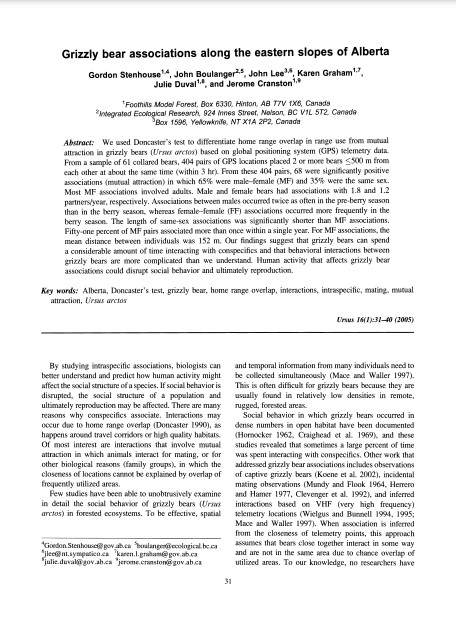Grizzly bear associations along the eastern slopes of Alberta
Bosque Modelo:
Foothills
Temática:
Conservación
Tipo de documento:
Artículo científico
Resumen
We used Doncaster's test to differentiate home range overlap in range use from mutual attraction in grizzly bears (Ursus arctos) based on global positioning system (GPS) telemetry data. From a sample of 61 collared bears, 404 pairs of GPS locations placed 2 or more bears <500 m from each other at about the same time (within 3 hr). From these 404 pairs, 68 were significantly positive associations (mutual attraction) in which 65% were male-female (MF) and 35% were the same sex. Most MF associations involved adults. Male and female bears had associations with 1.8 and 1.2 partners/year, respectively. Associations between males occurred twice as often in the pre-berry season than in the berry season, whereas female-female (FF) associations occurred more frequently in the berry season. The length of same-sex associations was significantly shorter than MF associations. Fifty-one percent of MF pairs associated more than once within a single year. For MF associations, the mean distance between individuals was 152 m. Our findings suggest that grizzly bears can spend a considerable amount of time interacting with conspecifics and that behavioral interactions between grizzly bears are more complicated than we understand. Human activity that affects grizzly bear associations could disrupt social behavior and ultimately reproduction
Información Bibliográfica
Autor:
Stenhouse, G.B., Boulanger, J., Lee, J., Graham, K., Duval, J., & Cranston, J.
Revista:
Ursus
Año:
2005
N°:
1
País :
Canadá
Páginas:
31 - 40
Volumen:
16
Idioma:
Ingles
Palabras claves
Alberta, Doncaster's test, grizzly bear, home range overlap, interactions, intraspecific, mating, mutual attraction, Ursus arctos





